The Olduvai effect: New questions about meat-eating in human origins
Meta-analysis of butchered animal bones from East African sites shows that long-held assumptions about early hunters may be wrong.
The old saying is “Manners maketh man”. But many anthropologists of the last century approached the past with the idea that it was meat, not manners, that mattered to our ancestors.
For much of the past fifty years, the broad consensus has been that meat-eating became more important to human ancestors after two million years ago. The idea has been that hunting and eating meat is connected with evolution of larger brain size—in other words, meat made us human. Most would say it was early Homo erectus, which first appeared in the fossil record just around two million years ago, that was the first species to really rely on meat.
But that consensus has been challenged recently. A big turning point was a 2022 meta-analysis that took a hard look at the evidence for hunting and meat-eating in East African sites across the period from 2.6 million up to 1.2 million years ago. The study, led by Andrew Barr with four coauthors, focused on zooarchaeological evidence: Cutmarks, percussion marks, and other direct evidence of butchery on bones. They found that there was no trend or change across the whole period. Barr and collaborators explicitly wrote that the “meat made us human” hypothesis does not fit their data.
Not all archaeologists will agree that Barr and coworkers proved their case. But this kind of meta-analysis of evidence across sites is going to be more and more central to work in human origins over the next few years. I decided to take a look at the way the traditional story developed, and how the new approach may show that the importance of meat for our ancestors and relatives is much broader than we thought.
Trek to Olduvai Gorge
Did meat-eating become more important over time or not? It seems like a simple question. Most answers have relied on close comparison of tools and fossil bones from some very rich archaeological sites.
The richest sites, which have generated the most data about meat-eating behavior, come from times after 1.9 million years ago. Maybe the best-known is the site at Olduvai Gorge known as FLK-22—also known as FLK-Zinj. Here, Mary Leakey’s excavations uncovered the OH 5 skull, named Zinjanthropus boisei when Louis Leakey described it in 1959.
As the Leakeys excavated FLK-Zinj, they uncovered a dense concentration of stone tools, hominin fossils, and animal bones. Many of the bones show signs that someone used stone tools to butcher the animals. Cutmarks trace the slicing movements of stone flakes that severed flesh and tendon from bone. Percussion marks show where chopping tools broke into the marrow.
The concentration of these stones and bones in an area of ancient landscape led Mary Leakey to consider that this had been a campsite organized by hominins.
Over the years these ideas were challenged by other archaeologists. Some proposed that the stone concentration was an accident of nature, possibly a place where a shade tree brought hominins back again and again. Many of the cutmarks were clear enough, but less clear was whether the hominins had killed the prey animals, or whether they may instead have taken carcasses or marrow bones from the kills of large cats or other carnivores. Such challenges became mainstay questions for the field as a whole from the 1970s forward.
As researchers pursued the “hunting versus scavenging” question, some made their careers by formulating more precise ways of understanding how stone tools, teeth, or hooves may leave marks and other traces on bones. Other researchers developed new approaches to consider the pattern of ages of prey animals, noting that some hunters tend to chase down the weak, very young, or old as their prey, while others wait for their prey in ambush and take animals of any age that happen near. Archaeologists started to frame the question in terms of access: Did the hominins have early access to a carcass, when most of the meat was still present, or late access after carnivores had mostly stripped the meat away?
In the decades since the Mary Leakey’s 1971 description of the site, these kinds of evidence have verified that hominins hunted some of the animals at FLK-Zinj and many other sites. At the same time—sometimes in the same sites—hominins also scavenged some kills that other carnivores made.
The hominins seem to have been flexible and strategic about meat. They made some opportunities for themselves and took advantage of opportunities made by others.
A meat bonanza
The FLK-Zinj site is only one of dozens of archaeological excavations at Olduvai Gorge over the years. The gorge itself is some 45 kilometers long, with a side gorge that branches off more than 15 kilometers, both cutting through more than 100 meters of hardened sediments from ancient lakeshores and the streams that flowed into them.
Patches of ancient landscapes are interleaved through the sequence. Archaeologists have traced where artifacts and fossils are naturally eroding from the deposits, removing tons of hardened sediments to expose large ancient surfaces.
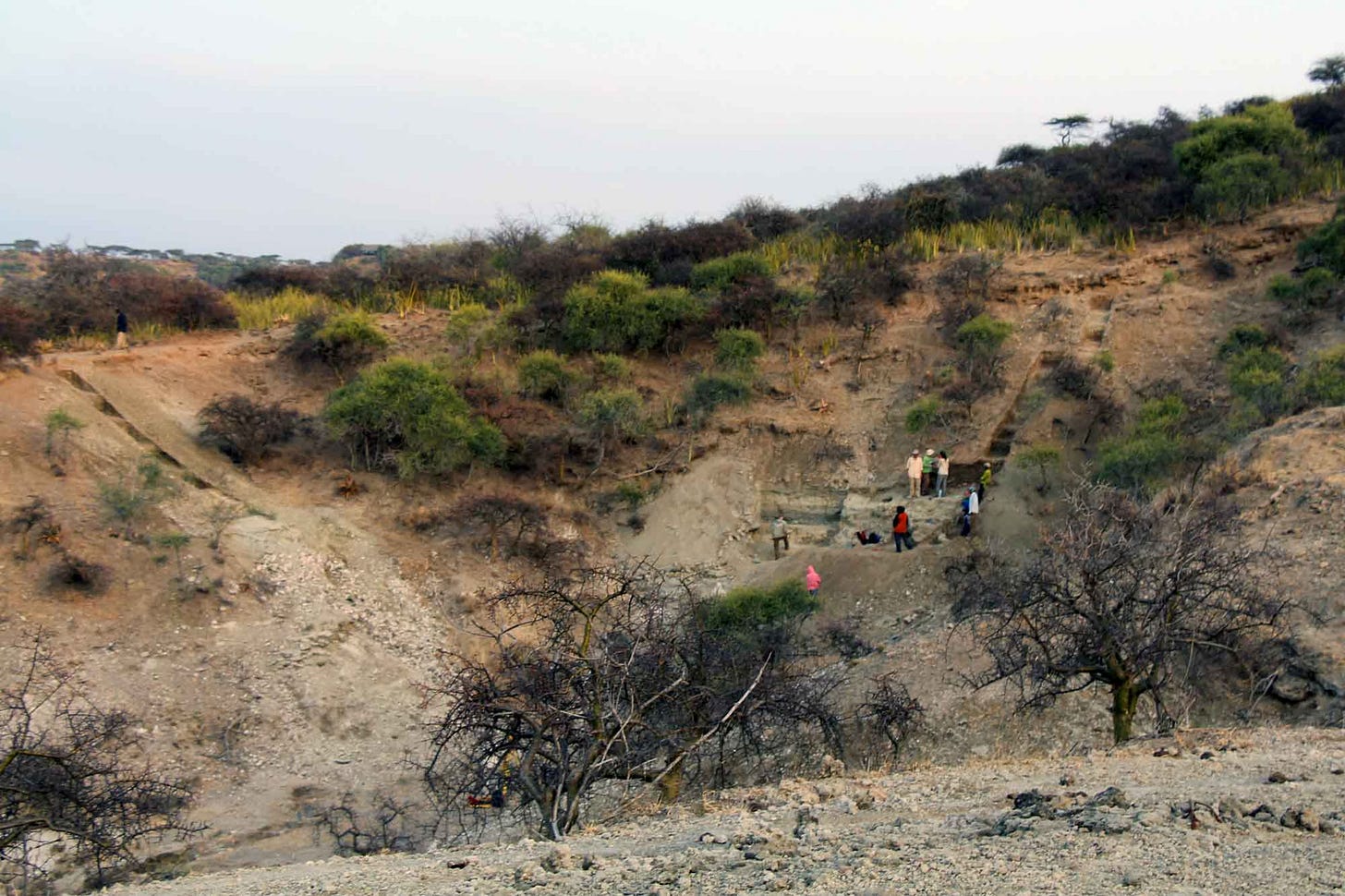
FLK-Zinj is in Bed I, the oldest part of this sequence around 1.85 million years old. Other parts of the gorge cut through the younger sediments including Bed II, after 1.4 million years.
One archaeological site in Bed II that has generated a great deal of data is the BK site, first investigated by the Leakeys during the 1950s in the years before they discovered the Zinjanthropus site. At BK, they found remains of many individuals of a large extinct buffalo, Pelorovis olduwayensis, which Louis Leakey interpreted as a mass kill.
The artifacts from the BK site seemed to include more “heavy duty” tools, and Mary Leakey hypothesized that these were an elaboration of the simple flake-based toolkits that she called Oldowan. She recognized these as an elaboration of the local Oldowan tradition, which she called Developed Oldowan.
In the early 2000s, a team of archaeologists led by Manuel Dominguez-Rodrigo returned to re-excavate the BK site. Their work added many new levels of information to the site, now estimated to be around 1.34 million years old. They confirmed that the hominins butchered bones from large animals, including Pelorovis and a giraffe relative known as Sivatherium. The hominins appear to have had early access to meat from these animals again and again across different levels.
Dominguez-Rodrigo and coworkers described this evidence of repeated kills as a “meat bonanza”. They emphasized that the repeated or systematic acquisition of meat from such large animals had never been observed at any earlier site. To be sure, there were some earlier sites with cutmarks or percussion on bones from large animals like hippos or rhinoceros. What these earlier sites lacked was evidence that the behavior was repeated again and again.
The Olduvai effect
I’m not alone in framing this history around sites from Olduvai Gorge. This exceptional place has been the best natural laboratory for some kinds of archaeological work.
It’s not that other places haven’t been very important to understanding hominin meat-eating. Around Lake Turkana, Kenya, are many places with tools and animal exploitation from the Early Pleistocene, including sites like FxJj50 that played a central role in the “hunting versus scavenging” debate. Newer discoveries, like the OGS12 and DAN5 sites from Gona, Ethiopia, have added to this record.
And those are just in East Africa. From Morocco to South Africa, and from Spain to China, archaeologists have found evidence of meat-eating by hominins across the Early Pleistocene.
Yet the intensity of investigations at Olduvai Gorge over the years has tended to exert a gravitational effect on archaeologists’ ideas. That bias has especially affected their ideas about the time that some behaviors became visible in the archaeological record. Andrew Barr and collaborators in their 2022 meta-analysis called this the “Olduvai effect”.
I chose my accounts of the FLK-Zinj and BK sites to illustrate this idea. These two sites are exceptionally rich, making it possible to look beyond a single happenstance toward a broader pattern of behavior. When researchers compare earlier and later sites directly with each other, they often perceive differences that suggest change over time.
Of course it takes more than two points to test for change over time. Today’s researchers draw upon data from many sites, looking for similarities and differences that may reflect local environments, or may indicate shifts in hominin strategies. But putting together evidence from different sites requires close consideration of the limitations of each, like counting seeds from apples and oranges and pumpkins.
The odds of finding great archaeology are in part a function of how hard archaeologists have looked, and in part a function of fortuitous geology. They’ve looked harder at Olduvai than anywhere else, precisely because the exposure of such a deep record with such good preservation is exceptional.
Barr and coworkers provided a helpful illustration showing the sheer number of bones from various sites with cutmarks, percussion marks and other evidence of hominin interactions. The variation across sites in this kind of evidence is so massive that Barr’s team chose to illustrate the square root of the number of bones instead of the actual number.
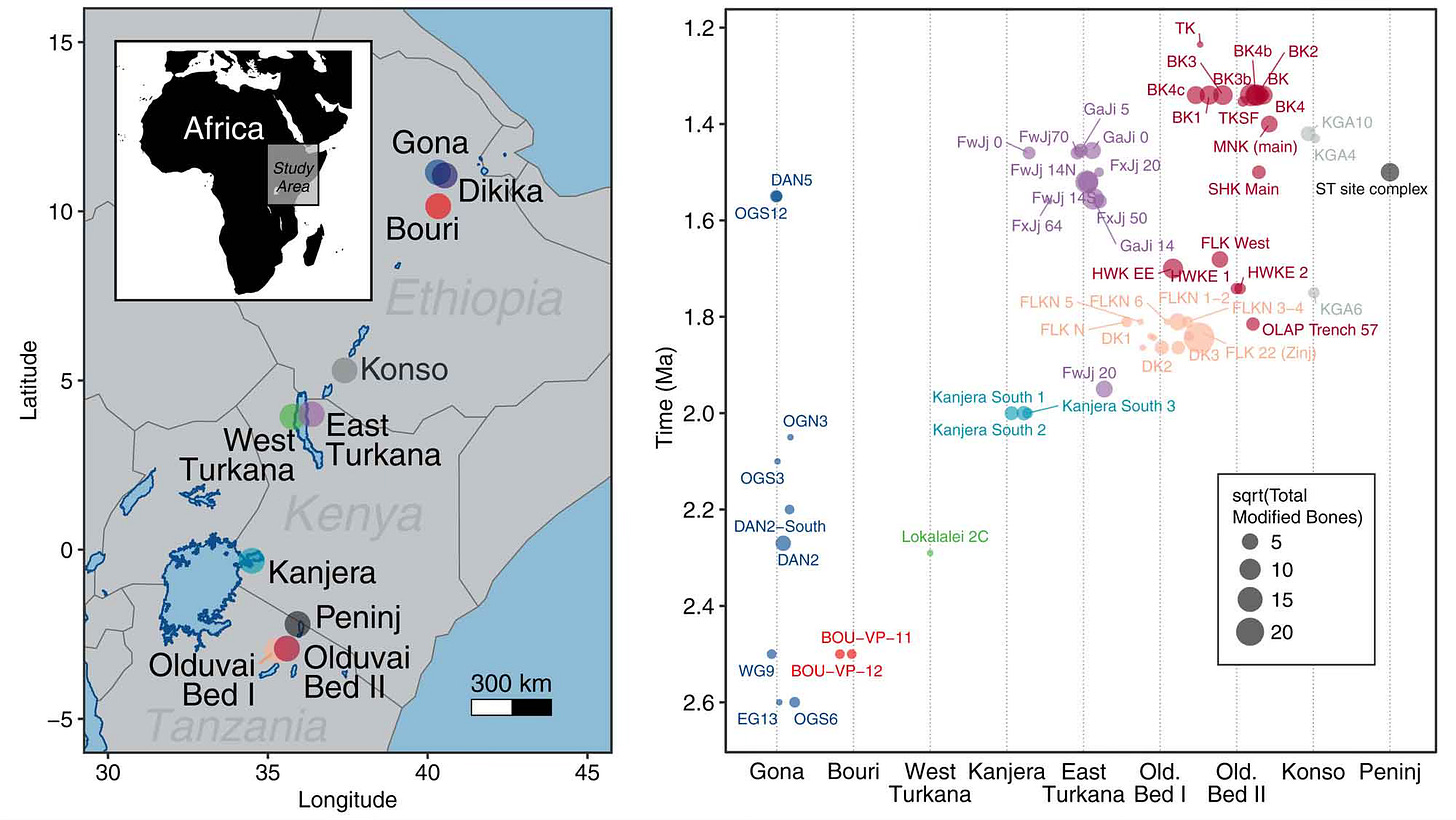
FLK-Zinj has hundreds of bones modified by hominins. Adding up the bones from every site across all of Ethiopia during the entire Early Pleistocene does not approach such numbers.
So Barr and coworkers formulated comparisons that looked at the intensity of hominin cutting and breaking bones in comparison to sample size. They found that early sites show similar intensity of hominin modification as later sites. Early sites don’t represent toolmakers that rarely touched meat; they represent relatively fleeting episodes of hominins that behaved the same as later ones.
“Our study demonstrates that the temporal pattern in the amount of evidence of hominin carnivory from 2.6 to 1.2 Ma is essentially flat, with no sustained increase through time.”—Andrew Barr and coworkers
Earlier samples
Archaeologists used to separate the sites earlier than two million years ago as something qualitatively different from the later sites, recognized with the name Pre-Oldowan. That distinction has been breaking down as archaeologists gather more information from earlier and earlier sites.
For example, the area of Kanjera South, Kenya, has several archaeological sites that date to around 2 million years ago—150,000 years earlier than FLK-Zinj. In 2013, Joseph Ferraro and coworkers reported on hominin cutmarks and carnivore tooth marks from three different archaeological levels. They found that all three of the animal bone assemblages suggested that hominins butchered the animals and carnivores ate some of the leftovers.
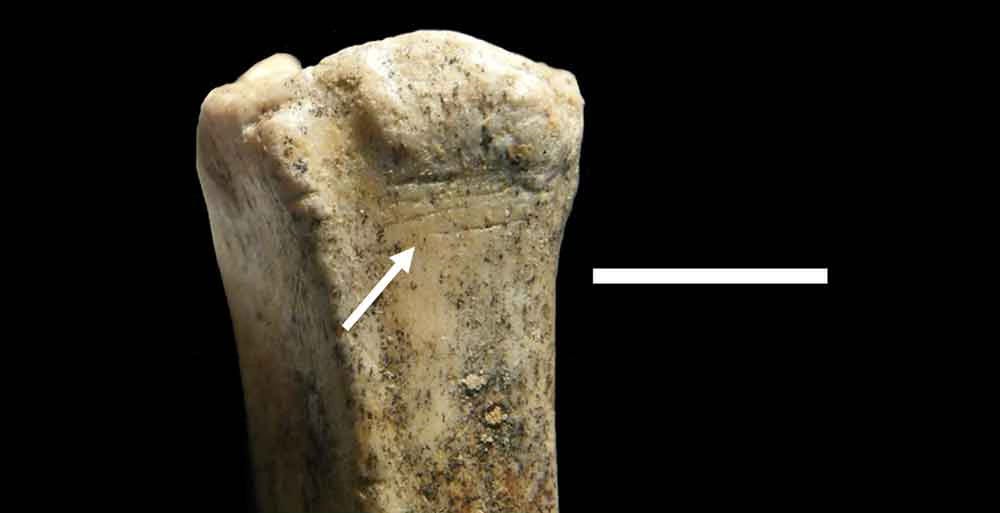
The oldest site known today with evidence of stone tools together with butchered animal remains is Nyayanga, Kenya, estimated between 3.0 and 2.6 million years. Thomas Plummer and his team of collaborators first reported on the site in 2023, so it was too late to be included in the study by Barr and coworkers. Nevertheless, it helps cement their findings. The Nyayanga stone flakes and cores occur together with cutmarked bones of hippopotamus. The site also has hominin remains: two large molar teeth that Plummer and coworkers attributed to Paranthropus.
In a growing number of cases, cutmarks and other evidence of butchery have been found on fossils from sites with no stone tools at all.
An example is Bouri, in the Middle Awash area of Ethiopia, with fossil remains around 2.5 million years old. Archaeologists in the 1990s located several bones with cutmarks, percussion marks, and green breaks, from antelopes and a kind of early horse. The first of these bones were found as the team, led by Tim White, were searching for pieces of a partial hominin skeleton.
There were no stone tools around the site. The skeleton includes neither skull nor teeth, and it’s not clear what species of hominin it may represent.
It’s one of the most interesting examples of early meat-eating, and it’s the ultimate example of the streetlamp effect. If archaeologists had not been searching intensively here for hominins, they would likely never have noticed the behavioral evidence around them.
The bigger picture
I’m interested in how we can we tie these ancient patterns of behavior to the hominin populations that made them. The time before two million years ago is important because evidence of the genus Homo is so scarce. While a few fossils have been identified as Homo in the period before 2.1 million years ago, I’m not very convinced that any of them represent something outside the variation of the various species of Australopithecus. When we’re looking at behavioral evidence from across 3 million to 1.2 million years ago, it’s inevitable that we’re looking at a broader part of the hominin tree than Homo alone.
As I’ve written before, the best explanation for the pattern of early archaeological traces is that many species and populations of hominins were making tools. Our close living relatives, chimpanzees and bonobos, all make tools, and their use of stone in cracking nuts is quite a small fraction of the range and complexity of tools that they produce. The ancient sites with stone tools are surely only a small visible fraction of a much larger repertoire of tool use by most early hominins.
The same is true of eating meat. Hominins had flexible diets, eating a broad range of foods. Meat has both nutritional value and social value for humans today, and for living chimpanzees and bonobos. Once stone cutting edges came into use, meat-eating became highly visible in the archaeological record, especially compared to eating most plant foods. But I would be very surprised if there were any hominin species that didn’t sometimes eat animal prey.
Barr and coworkers show that today’s evidence is just too sparse to show differences over time. That’s important to recognize.
But it’s also important to recognize the limitations of their analysis. By limiting to the East African sites, it leaves out the broad array of evidence from Eurasia, southern Africa, and northwest Africa from the same time period. The cutoff at 1.2 million years also separates their comparisons from somewhat later sites like Olorgesailie, Kenya, that have a lot more signs of eating large mammals like elephants. With this cutoff the observations at a site like BK seem like outliers in a long period of stasis. By opening the window somewhat later, those observations seem more like early spurts of megafaunal exploitation that became more regular later in time.
More important, zooarchaeology is only one line of evidence. Even the richest sites with abundant evidence of early carcass access like the levels at BK do not allow an estimate of the quantity of meat that hominins ate, or its importance relative to other foods. Biologists have worked to understand diet through the examination of microscopic wear traces on hominin teeth, through sampling of isotopic and elemental composition of teeth and bone, through the association of hominin fossils with archaeological material, and with the functional anatomy of their jaws.
So to refine the question at the top of the post: It’s not whether meat-eating became more common over time that matters. It’s whether we can tie meat-eating to particular branches of the hominin tree.
I think there is a lot of promise in combining the evidence to show how meat-eating may have mattered to some species more than others. Considering the behavioral flexibility that was shared by all these hominins, my intuition is that the picture won’t be simple.
Notes: This post covers a lot of ground in zooarchaeology in a fairly superficial way. Each step in this story has dozens of research articles that could be drawn into the discussion. As I mention at the end of the post, there are many additional sources of evidence about ancient diets that may provide more information about the nutritional and dietary importance of various foods. Even if each is limited in what it can say, integrating these sources of evidence is the great challenge of understanding hominin diet evolution.
At Olduvai Gorge, the small gullies that spill into the gorge are called “korongos”, and many of them were named by the Leakeys, giving rise to site names. “FLK” is Frida Leakey Korongo; BK is “Bell’s Korongo”.
Cutmark and other bone modification evidence can be hard to interpret because similar marks can be made by different processes. For example, some of the marks on Bouri bones were shown by Yonatan Sahle and coworkers in 2017 to be similar to marks made by crocodiles. Early marks on bones from Dikika, Ethiopia, which would be the world’s oldest at around 3.3 million years have likewise been subject to scrutiny.
Jessica Thompson and coworkers in 2019 published an article that reframes the topic of meat-eating by early hominins, recognizing that “meat” usually denotes muscle tissue from outside bones, and some of the most valuable resources for early hominins may have been the marrow and fat inside bones. Their take on the initial record for animal consumption is a useful one. I didn’t have space for this issue within this post but hope to revisit it later.
References
Barr, W. A., Pobiner, B., Rowan, J., Du, A., & Faith, J. T. (2022). No sustained increase in zooarchaeological evidence for carnivory after the appearance of Homo erectus. Proceedings of the National Academy of Sciences, 119(5), e2115540119. https://doi.org/10.1073/pnas.2115540119
Domínguez-Rodrigo, M., Bunn, H. T., Mabulla, A. Z. P., Ashley, G. M., Diez-Martin, F., Barboni, D., Prendergast, M. E., Yravedra, J., Barba, R., Sánchez, A., Baquedano, E., & Pickering, T. R. (2010). New excavations at the FLK Zinjanthropus site and its surrounding landscape and their behavioral implications. Quaternary Research, 74(3), 315–332. https://doi.org/10.1016/j.yqres.2010.07.003
Domínguez-Rodrigo, M., Bunn, H. T., Mabulla, A. Z. P., Baquedano, E., Uribelarrea, D., Pérez-González, A., Gidna, A., Yravedra, J., Diez-Martin, F., Egeland, C. P., Barba, R., Arriaza, M. C., Organista, E., & Ansón, M. (2014). On meat eating and human evolution: A taphonomic analysis of BK4b (Upper Bed II, Olduvai Gorge, Tanzania), and its bearing on hominin megafaunal consumption. Quaternary International, 322–323, 129–152. https://doi.org/10.1016/j.quaint.2013.08.015
Ferraro, J. V., Plummer, T. W., Pobiner, B. L., Oliver, J. S., Bishop, L. C., Braun, D. R., Ditchfield, P. W., Iii, J. W. S., Binetti, K. M., Jr, J. W. S., Hertel, F., & Potts, R. (2013). Earliest Archaeological Evidence of Persistent Hominin Carnivory. PLOS ONE, 8(4), e62174. https://doi.org/10.1371/journal.pone.0062174
Heinzelin, J. de, Clark, J. D., White, T., Hart, W., Renne, P., WoldeGabriel, G., Beyene, Y., & Vrba, E. (1999). Environment and Behavior of 2.5-Million-Year-Old Bouri Hominids. Science, 284(5414), 625–629. https://doi.org/10.1126/science.284.5414.625
Leakey, L. S. B. (1959). A New Fossil Skull From Olduvai. Nature, 184(4685), 4685. https://doi.org/10.1038/184491a0
Leakey, M. D. (1971). Olduvai Gorge: Volume 3, Excavations in Beds I and II, 1960-1963. Cambridge University Press.
Plummer, T. W., Oliver, J. S., Finestone, E. M., Ditchfield, P. W., Bishop, L. C., Blumenthal, S. A., Lemorini, C., Caricola, I., Bailey, S. E., Herries, A. I. R., Parkinson, J. A., Whitfield, E., Hertel, F., Kinyanjui, R. N., Vincent, T. H., Li, Y., Louys, J., Frost, S. R., Braun, D. R., … Potts, R. (2023). Expanded geographic distribution and dietary strategies of the earliest Oldowan hominins and Paranthropus. Science, 379(6632), 561–566. https://doi.org/10.1126/science.abo7452
Sahle, Y., El Zaatari, S., & White, T. D. (2017). Hominid butchers and biting crocodiles in the African Plio–Pleistocene. Proceedings of the National Academy of Sciences, 114(50), 13164–13169. https://doi.org/10.1073/pnas.1716317114
Thompson, J. C., Carvalho, S., Marean, C. W., & Alemseged, Z. (2019). Origins of the Human Predatory Pattern: The Transition to Large-Animal Exploitation by Early Hominins. Current Anthropology, 60(1), 1–23. https://doi.org/10.1086/701477


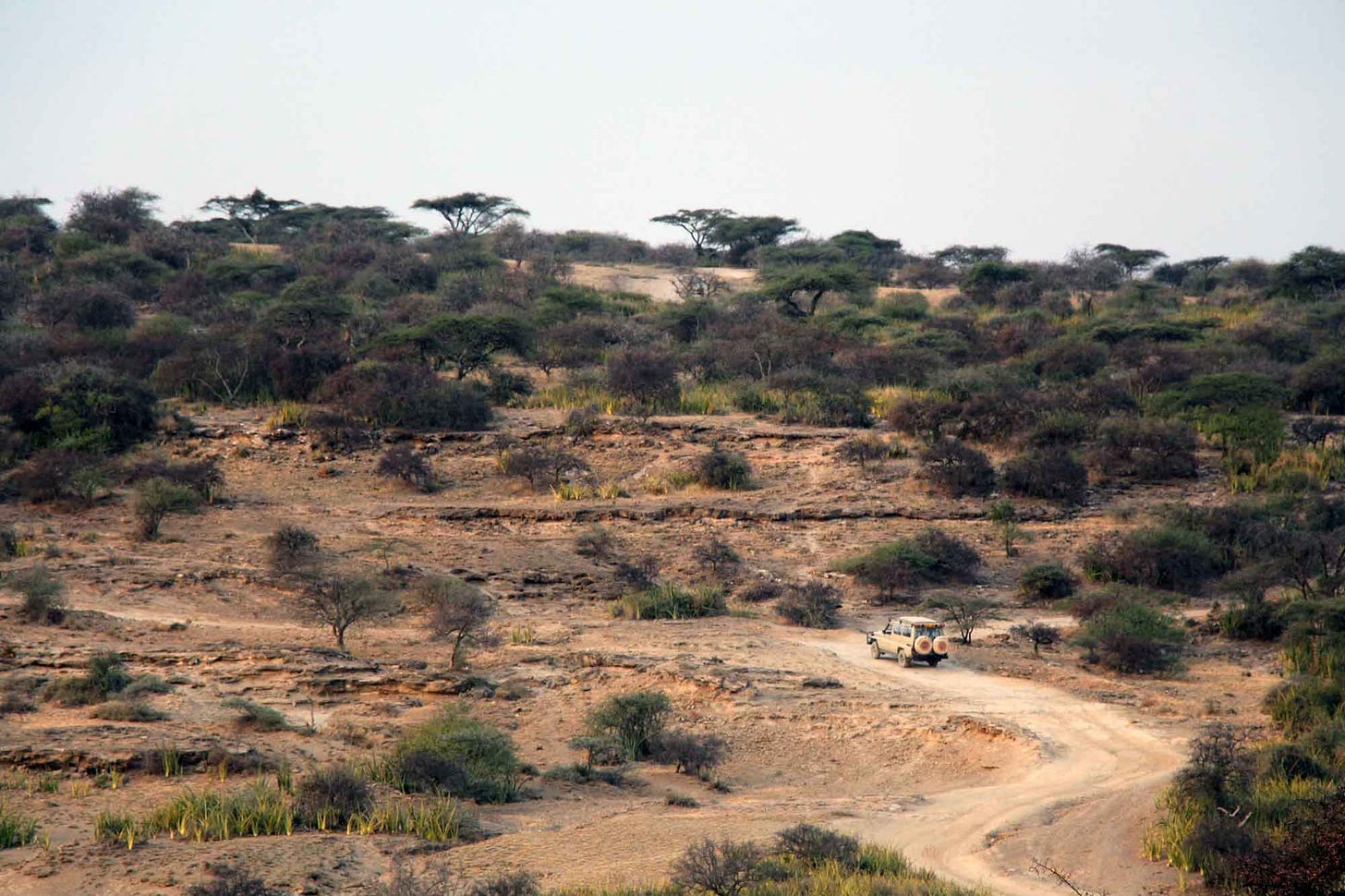
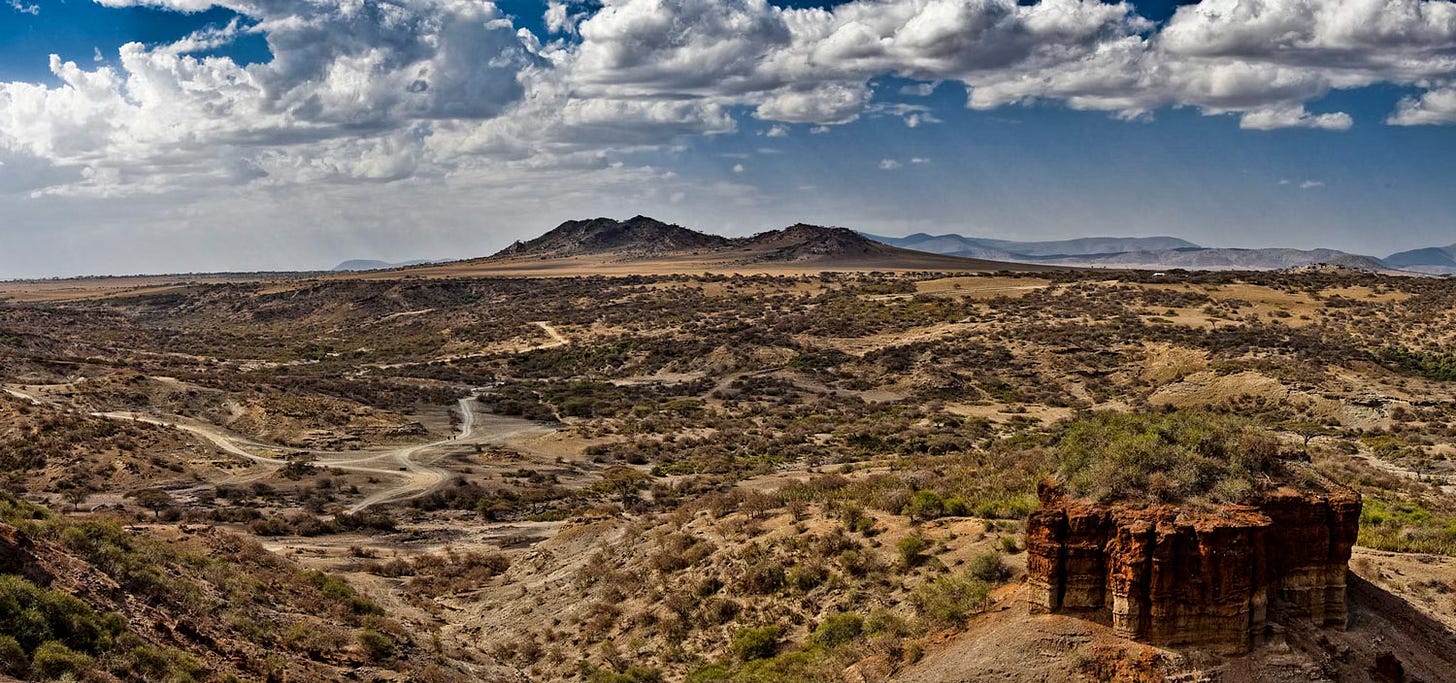
Gut morphology and the avoidance of carrion among chimpanzees, baboons, and early hominids
S Ragir, M Rosenberg, P Tierno
Journal of Anthropological Research, 2000•journals.uchicago.edu
Meat-eating primates avoid scavenging for dietary protein and micronutrients even when carrion is relatively fresh. Chimpanzees, baboons, and modern hunter-gatherers supplement their diets of high-energy, low-protein fruit with protein obtained from leaves, insects, and animal prey. Most primates, especially leaf-eating primates, digest the cellulose cell walls of ingested plant material in a well developed caecum and/or large intestine through fermentation caused by enzymes released by their normal gut flora. The primate digestive strategy combines a rapid passage through the stomach and prolonged digestion in the ileum of the small intestine and caecum, and this combination increases the likelihood of colonization of the small intestine by ingested bacteria that are the cause of gastrointestinal disease. Carrion is very quickly contaminated with a high bacterial load because the process of dismemberment of a carcass exposes the meat to the bacteria from the saliva of the predator, from the digestive tracts of insects, and from the carcasses' own gut. Thus, the opportunistic eating of uncooked carrion or even unusually large quantities of fresh-killed meat by nonhuman primates or humans is likely to result in gastrointestinal illness. We propose that among meat-eating primates, carrion avoidance is a dietary strategy that develops during their lifetime as a response to the association of gastrointestinal illness with the ingestion of contaminated meat from scavenged carcasses. This has important implications for our understanding of early hominid behavior.